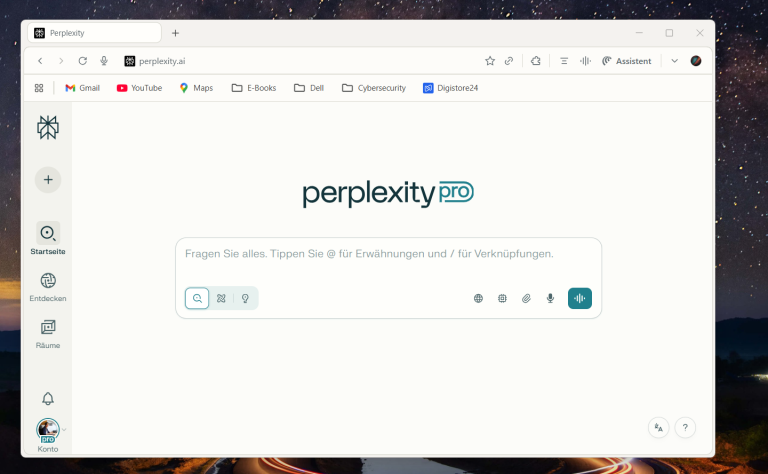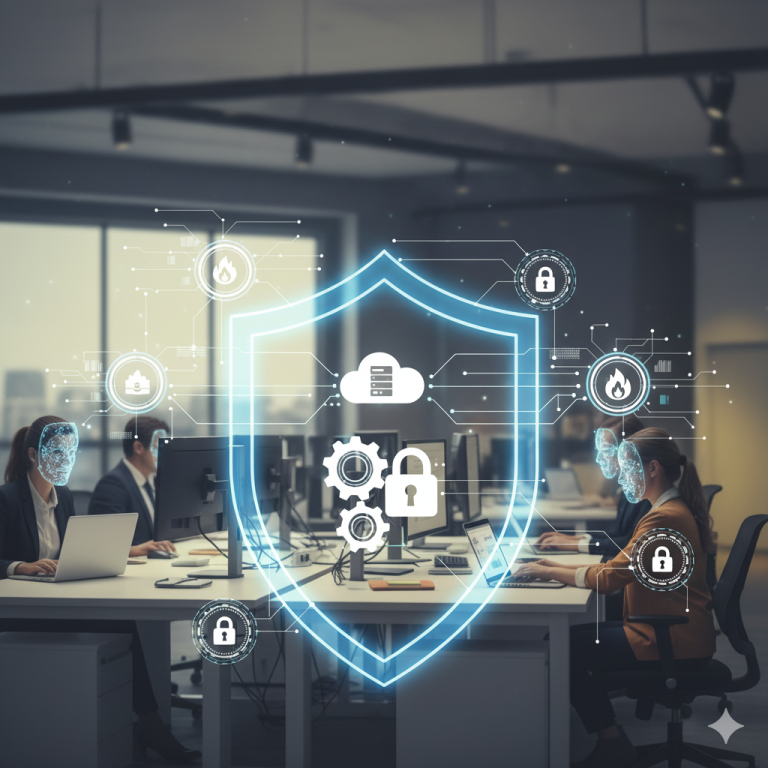The dark web has exerted an almost mystical fascination for years. Many people only know it from films or headlines portraying it as a dark marketplace for drugs, weapons, or stolen data. This reputation causes most people to immediately associate the term with crime—but that’s only part of the truth.
The dark web is actually a protected area of the internet that isn’t accessible via Google or other search engines. It was developed to provide people with greater anonymity and privacy in the digital space. Activists in repressive states, investigative journalists, and whistleblowers use it to communicate securely and unobserved. But it can also be useful for ordinary users who value data protection.
At the same time, the dark web naturally poses risks: Insecure websites, fraudulent marketplaces, and malware lurk there just as they do on the visible internet—only they are often harder to detect. Therefore, it’s important to understand the basics and be familiar with security measures before entering this part of the network.
This article provides an overview of the darknet basics : what it actually is, how you can access it securely, and which rules you should definitely follow if you want to navigate anonymously and safely. This will give you a realistic picture beyond Hollywood myths and scaremongering – explained in a practical and understandable way.
What exactly is the darknet?
To understand the darknet, it helps to differentiate between the different levels of the internet:
Deep Web vs. Darknet
The Deep Web
The Deep Web encompasses all content that is not indexed by search engines such as Google or Bing . This includes, for example:
-
internal corporate intranets
-
Databases of universities and libraries
-
Online banking systems
-
private cloud storage such as Google Drive or Dropbox
-
protected areas of websites (e.g. with password or login)
In other words, every time you log into a platform with your password, you’re already moving into the deep web. Estimates suggest that the deep web accounts for over 90% of the entire internet —far more than the “visible” surface you know from Google or other search engines.
The Darknet
The Darknet is a small, specialized section of the Deep Web that intentionally remains hidden. Unlike the regular Deep Web, logging in with a password isn’t enough. Instead, you need special software or networks to even gain access. The most well-known of these are:
-
Tor (The Onion Router) – the world’s most popular darknet network, accessible via the Tor Browser
-
I2P (Invisible Internet Project) – focuses on anonymized communication and peer-to-peer services
-
Freenet – a decentralized network designed to be censorship-resistant
Websites in the darknet usually have the extension .onion (for Tor) or .i2p (for I2P) and cannot be accessed via normal browsers such as Chrome, Edge or Firefox .
Legitimate use of the darknet
Although the dark web is often associated with illegal activities, there are numerous legitimate and important use cases :
Anonymous communication for activists in authoritarian states
In countries with heavy censorship or extensive surveillance, the dark web is often the only way to freely exchange information. Dissidents, opposition figures, and civil rights activists use it to communicate with the world uncensored without revealing their identities.
Secure whistleblower platforms
Services like SecureDrop and GlobaLeaks allow whistleblowers to anonymously submit documents to journalists or NGOs. Renowned media outlets like The Guardian and The New York Times operate their own darknet addresses to ensure secure contact for whistleblowers.
Protection of privacy for journalists and lawyers
Journalists can talk to their sources on the dark web without risking traceability. Lawyers and human rights organizations also use dark web services to encrypt sensitive communications and protect their clients’ anonymity.
Forums and communities that deliberately wish to remain anonymous
Some groups value the darknet simply for the anonymity it offers. Discussion forums exist there on topics such as politics, technology, or health that might be stigmatized, censored, or monitored on the “normal” internet.
👉 This makes it clear: The dark web is not illegal per se . It’s a tool—and like any tool, it depends entirely on who uses it and for what purpose .
Access: How do you get into the dark web?
Getting started on the dark web is technically easier than many people believe. However, it’s important to use reputable sources and keep your security in mind from the start . The following three steps are the foundation:
1. Install Tor Browser
The Tor Browser is the most popular and secure tool for accessing the dark web.
-
It’s based on Mozilla Firefox , so it looks similar, but is specifically designed to protect your anonymity .
-
Officially, you can download it for free from the Tor Project website: torproject.org .
How Tor (The Onion Router) works:
-
Your data traffic is forwarded via at least three randomly selected nodes in the global Tor network.
-
Each of these nodes encrypts only part of the connection – similar to the layers of an onion (hence the name Onion Routing ).
-
This makes it extremely difficult to trace your IP address.
👉 Important: Only download the Tor Browser from the official site ! Unofficial downloads may be tampered with or infected with malware.
2. Visit .onion websites
-
On the normal Internet, domains usually end with .com , .org or .de .
-
On the darknet, however, the addresses have the .onion extension . These are accessible only via the Tor Browser.
Examples of darknet sites:
-
Whistleblower platforms (e.g. SecureDrop)
-
Darknet wikis with link lists
-
Anonymous forums and communities
But be careful:
-
Onion links cannot be found via Google or Bing .
-
Instead, they circulate in special forums, wikis, or communities. However, many of these links are outdated, inactive, or dubious .
-
There are also numerous fake sites that disguise themselves as well-known darknet services, but whose sole aim is to deceive visitors or steal data.
👉 Tip: To get started, you can use well-known and community-reviewed resources like the Hidden Wiki (a kind of link directory on the dark web). However, even there, be very discerning about which links you click.
3. Use a VPN (optional, but recommended)
Even if the Tor Browser anonymizes your connection, internet providers can still detect that you’re using Tor. In some countries, this is enough to raise suspicion.
You can conceal this step with a VPN (Virtual Private Network) :
-
First, connect to the VPN.
-
Then open the Tor Browser.
-
To your provider, it will then appear as if you are simply connected to a normal VPN server.
Advantages:
-
Additional security layer (especially useful in public Wi-Fi networks)
-
Protection from curious internet providers or network operators
-
Prevents your real IP address from being visible in case the Tor Browser has a vulnerability
But be careful:
-
Choose a VPN with a no-log policy (e.g. Mullvad, ProtonVPN or NordVPN).
-
You should avoid free VPNs because they often collect data or are unstable.
👉 Additional tip for maximum security:
Many experienced users recommend using the dark web in a virtual machine (VM) or a separate operating system (e.g., Tails OS ). This completely isolates your dark web activities from your everyday computer.
Security Basics: How to Surf the Darknet Safely
The dark web can offer you a high degree of anonymity—but only if you handle your data and behavior with care. Many beginners make the mistake of feeling too secure and thereby leaving traces. The following basic rules are your foundation for staying safe:
1. Do not disclose personal information
-
Taboo: real name, address, phone number, private email or photos.
-
Even the smallest details – such as your writing style, hobbies or a profile picture – can be enough to have you deanonymized.
Solution:
-
Always create separate accounts with fictitious names for darknet access.
-
Use disposable email addresses (e.g., ProtonMail or Tutanota with Tor access).
-
Never use the same passwords as in your “normal” internet life.
👉 Example: Even a careless mention of your city or profession in a forum can be enough to recognize you later.
2. Avoid downloads
-
The dark web is full of files that appear harmless at first glance (PDFs, images, ZIP archives) – in reality, many of them contain Trojans or ransomware.
-
Just opening it can be enough to compromise your system.
Tips:
-
Never download anything unless it is absolutely necessary.
-
If so:
-
Only open files in an isolated virtual machine (VM) that is separate from the rest of your system.
-
For this purpose, use VirtualBox or VMware , for example.
-
The safest option is a live operating system like Tails OS , which deletes all traces when rebooting.
-
3. Passwords & Two-Factor Authentication (2FA)
-
There are also phishing sites and fake logins on the darknet that only aim to steal your login information.
-
Therefore, use strong, unique passwords (preferably with a password manager that also works offline).
-
If a service offers it, activate 2FA (two-factor authentication), preferably with apps like Aegis or Authy .
👉 Important: Never use the same passwords you use on the clearnet (the regular internet). Even one compromised account can destroy your anonymity.
4. No JavaScript or plug-in usage
-
Danger: JavaScript and browser plugins can reveal your identity by revealing small pieces of information about your system (e.g., screen resolution, installed fonts, add-ons).
-
Tor Browser Solution: JavaScript is already restricted in standard mode. Leave the settings as they are.
-
Do not install any additional plugins or add-ons – even seemingly harmless tools can compromise your anonymity.
👉 Example: A single video playback plugin could reveal your real IP address without you noticing.
5. Avoid illegal activities
-
The darknet is notorious for marketplaces where drugs, weapons, stolen data, or forged documents are traded.
-
Legal consequences: Even attempting to engage in this activity can be punishable. Law enforcement agencies are also active on the dark web and sometimes even operate fake marketplaces to expose buyers.
-
Even simply visiting such sites can pose risks – for example, through compromised links or tracking.
👉 Remember: The dark web itself isn’t illegal—but much of the content there is. Use it for privacy and anonymity, not for prohibited activities.
6. Bonus: Additional security measures
-
Regular updates: Always keep the Tor Browser and your operating system up to date.
-
Separate device/profile: Ideally, use a separate laptop or at least a separate user profile for darknet activities.
-
Trustworthy sources: Use well-known darknet wikis or forums, but don’t blindly click on every link.
-
Common sense: If something sounds “too good to be true” (e.g., free Bitcoins or super deals), there’s a 99% chance it’s a scam.
👉 In summary: Your biggest security vulnerability is yourself . Technical tools like Tor and VPN offer protection, but they are only as strong as your behavior. If you remain disciplined and cautious, you can use the dark web without taking unnecessary risks.
Useful tips for beginners
When you first explore the dark web, many things may seem confusing and unfamiliar. The following tips will help you avoid common beginner mistakes and navigate more confidently and structuredly from the start:
1. Use trusted resources
-
Forums & Wikis for Beginners:
Well-known entry-level sites like Hidden Wiki or other dark web wikis offer link directories to help you get started.
In forums like Dread (a kind of Reddit for the dark web), you’ll find discussions, reviews, and warnings about reputable sites—or not. -
Be careful with link lists:
Many links circulating on the regular internet are outdated or lead to fake sites that simply distribute malware or phishing.
Don’t blindly rely on the first source you find – check whether other users also recommend the same site.
👉 Tip: Create your own private link list that you check and maintain regularly, instead of clicking through the web every time.
2. Update the Tor Browser regularly
-
The Tor Browser is your gateway to the darknet – and like any software, it is not free from security vulnerabilities.
-
Updates close known vulnerabilities that could otherwise be exploited by attackers.
-
Therefore, update the Tor Browser regularly via the official website or directly via the integrated update function.
👉 Note: Many hacks on the dark web are not carried out by “super hackers,” but by users using outdated software .
3. Isolate your darknet surfing from the rest
-
To minimize your risk, you should clearly separate your darknet activities from the rest of your online world.
Possibilities:
-
Your own browser: Only use the Tor Browser for darknet sites – never Chrome, Edge, or Firefox.
-
Separate user profile: Set up a separate user account on your computer just for darknet activities.
-
Virtual Machine (VM): Use programs like VirtualBox or VMware to set up an isolated environment.
-
Tails OS: This operating system runs directly from a USB stick. After rebooting, all traces are erased—ideal for maximum anonymity.
👉 Pro tip: Some experienced users even use a separate laptop exclusively for the dark web.
4. Combine with secure communication
-
If you want to not only browse the dark web but also communicate, use encrypted email and chat services .
Examples:
-
ProtonMail: Offers its own onion address, which allows you to access your emails directly on the dark web.
-
Tutanota: Also a secure email service with end-to-end encryption.
-
Ricochet or Session Messenger: Chat apps that run over Tor and don’t require a phone number.
Why important?
-
Regular email providers like Gmail or Outlook are not secure on the dark web and can put your identity at risk.
-
Encrypted communication provides additional protection if someone monitors your connection.
5. Extra tips for beginners
-
Familiarize yourself with Tor security: Click the onion icon in the Tor Browser to view details about your connection’s encryption.
-
Leave no trace: Regularly delete cookies and cache or use the “New Identity” function.
-
Skepticism is a must: Fraud is commonplace on the dark web. If something sounds “too good to be true,” it almost always is.
-
Take your time: Don’t jump straight to every site or service. Take your time to get to know the environment and the community.
👉 These tips will help you build a solid foundation. The dark web remains a special place, but if you follow the basics , you can use it safely and purposefully – without putting yourself at unnecessary risk.
Conclusion: Darknet simply explained – this is how safe surfing works
The dark web seems like a mysterious and dangerous place to many—but it’s primarily a tool. Used correctly, it offers you privacy, anonymity, and access to information unavailable on the regular internet.
It is important that you internalize the basics :
-
Only access the dark web with the Tor Browser (and ideally a VPN).
-
Do not disclose any personal information and always remain skeptical.
-
Avoid downloads and strictly separate passwords and accounts.
-
Focus on reputable and trustworthy sources .
This makes it clear: “Darknet Simply Explained” primarily means taking your own security rules seriously. If you remain disciplined, you can surf safely, communicate anonymously, and take advantage of the positive aspects of this hidden network – without taking unnecessary risks.
You can download the Tor Browser here:
https://www.torproject.org/download
You may also be interested in





